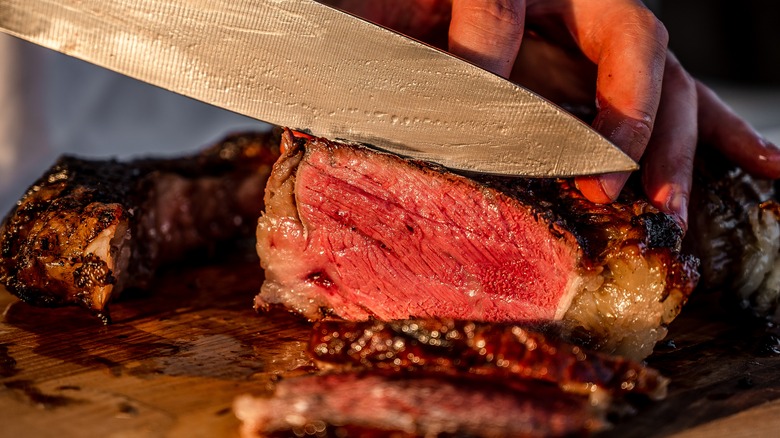The Simple Steak Tip Rachael Ray Always Follows
If there's any Food Network star who knows how to make good cooking approachable, it's Rachael Ray. Whether it's helping introduce extra-virgin olive oil into kitchen vocabulary as "E.V.O.O." (via Mercury News) or showing viewers how to create delicious meals in less than a half-hour on "30 Minute Meals," she has likely inspired not only home cooks but also celebrities, per ET. In fact, one of the greatest lessons Ray has learned in her Food Network career is the importance of being accessible and open-minded.
In a recent Instagram video, Ray turned her attention to steak – a dish everyone makes plenty of mistakes while preparing. As she shared in the short clip she uploaded, there's one step she never skips when she's making steak: Bring it to room temperature before cooking it. Why does Rachael Ray advise home cooks to let their steaks rest on the counter before searing — and why should you follow her guidance?
Rachael Ray's room temp trick prevents a sticky situation
There are a couple of reasons to let steak come up to room temperature, and they all boil down to the importance of never putting cold meat in a hot pan. The fibers very quickly contract, pushing out the precious juices that would make your steak moist. As Rachael Ray said on Instagram, "Seize the day...not your steak." Plus, cold meat cools the pan and disrupts the reactions that transform proteins on the meat's surface (via Washington Post), which not only prevents a deliciously caramelized sear but also can cause your steak to stick.
However, simply letting your ribeye or New York strip come to room temp isn't a magical guarantee of a perfect steak. A common myth about steak is that letting meat come to room temperature prevents a grayish band between the outside crust and pink interior. This is false – you may need to use a technique called reverse searing to slowly cook the steak before getting a hard sear to avoid discoloration (via Cook's Illustrated).
The way you season your steaks has a significant effect on your final meal, too. Don't be skimpy on the kosher salt, per The Spruce Eats. And as for timing, either season your steaks immediately before they hit the hot pan or more than 40 minutes beforehand to give the salt time to work its way into the meat and create what J. Kenji Lopez-Alt calls "built-in seasoning," per Serious Eats.

